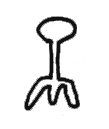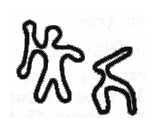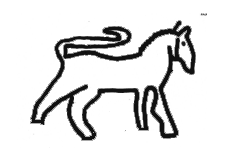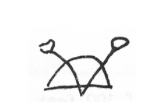The Wemyss Caves

Time Team working in the Well Cave
The name of Wemyss is derived from the Celtic UAMH that means cave.
About 6,000-7,000 B.C., the sea formed a series of caves in the sandstone cliffs. Between this date and 3,000-4,000 B.C. the land rose 8 meters and another series of caves were formed. The land then rose another 8 meters so that today we have two series of caves:- one series at the 16 metre level and one series at the 8 metre level.
The Wemyss caves have been used by many people over thousands of years and for a variety of purposes: from cave dwellers, the Picts, early Christians, Norsemen and smugglers, to the present day. Unfortunately they now suffer from misuse, wilful damage and neglect. It has been said that there are more markings in the Wemyss caves than all the other caves in Britain put together. The only other caves like Wemyss are at Covesea Cove, Moray Firth, and there are only one or two there.
 Trident
Trident
The markings can be grouped under three headings:-
1. Pre-Christian 2. Christian 3. Viking
The Pre-Christian markings are on the whole Pictish in origin, as can be seen on many cross-slabs all over the country. They Include 'elephant' figures, animals, mirror and comb and double disc or 'spectacle ornaments'. The Christian markings are again Pictish, but they include the fish, the early Christian symbol, and cross markings. The Viking markings are symbolised by the Norse Gods, Thor with his Hammer followed by the sacred goat, Freya portrayed by the goose and Odin by the trumpet form.
There are three types of markings:-
1. Pecked 2. Scooped 3. Line
The only known example of pecked marking is the 'Hunting Scene' found in the Michael cave, where the outline was made by a series of holes. The scooped markings are very shallow, with the middle of the figure hollowed out, e.g. the boat in Jonathan's Cave. Line markings have been made with a round pointed tool and only the outline is drawn in. They are deeper than the 'scooped' markings. It is interesting to note that the Pictish markings were thought to be funereal until they were found in the Wemyss Caves. Unfortunately there are many markings which have been etched in modern days. They include initials, dates, and there is even a fish in Jonathan's Cave. Comparing this horizontal fish with the original, it can be seen that the modern fish has been made with a knife. The only other man-made things in the caves were made by the original inhabitants. Ledges and benches have been cut out in some of the caves, and 'hold-fasts' have been made in the walls
 Thor & goat
Thor & goat
The Court Cave
In the days of the Livingstones and Colvilles, who owned Macduff Castle from the 15th to the 17th centuries, the "Baron Courts" were held in this cave, but some people trace its name to the time when James V, disguised as "The Guidman of Ballengeich", had an incident with the gypsies, who were in the cave at the time .
This cave was also named "The Barque Cave", because fishermen used to barque or tan their nets in the cave. Another name was "The Pipers Cave", because of the legend that a piper marched into the cave playing his pipes and was never seen again.
The East and West Doo Caves
In the middle ages, only Lairds and Burghs were allowed to keep pigeons, to provide fresh meat in the winter when cattle were too scrawny to be worth killing. The turnip was not introduced until the 18th century, to provide fodder to keep cattle fat in the winter. Pigeons were also included in the dowry for the Laird's daughters.
 Boat
Boat
The Well Cave
This cave received its name because of the well of clear water which it once contained. The water was said to cure Jaundice and other illnesses. It is possible that the well was there in the days of the Picts and could have been the reason for the "Hansel Monday"* custom. This custom took place on the first Monday after 11th January, when residents of East-Wemyss, especially the young men and girls, went in a torch-light procession to the cave with wine and cakes.
There, they sang hymns and psalms round the well and before they left, they had a drink from the well. This was a continuation of the old Celtic New Year Yule festival, when the "fairy piper" was said to come to the cave and summon the wicked, and then Tir-nan-og wiled away the mortals to the land of eternal youth.
In the days of the Picts, the well was the mother of the spring, the spring was the mother of the river, and the river flowed down to the sea, and so the well was worshipped. When Christianity came to Scotland the custom was "Christianised" and the well was named St. Margaret’s well.
*Hansel Monday - After 1752 when 11 days were lost between September 2nd - 13th- the Scots resented their lost days - and so held Hansel Monday on the first Monday after the llth of January.
St. Margaret's Well.
This cave is a double cave. An entrance cave is joined by a short, low, connecting passage to a magnificent domed cave 20 metres long and 17 metres wide, the roof being 8 metres to 10 metres above the sandy floor. A passage led from the cave to the castle above and gives the cave its other name of "Castle Cave". There is only one marking in the entrance cave, although there are ledges and holes that could have been used in olden days, but there are no markings (other than initials and dates) in the "Well Cave" itself. Unfortunately, though this, to my mind, is one of the most interesting caves, it is also the most dangerous.
Un-named Cave
This cave lies on the east of the "Well Cave".
An inventory of the caves in 1956 revealed that the roof had fallen in at each side of the cave. There are still other caves which are partially filled in like the cave on the west side of the "Well Cave" and some are completely filled in. Who knows what archaeological treasures they contain.
Jonathan's Cave
All drawings are to be found on the west wall, except the drawing of a ship on the east wall, which was discovered by the late George B Deas who was the Authority on the Wemyss Caves. This is the oldest drawing of a ship in Scotland, and is probably a Pictish ship. The drawing of the swan on the west wall makes one wonder if "Jan Mor Nan Uaimh" (Muckle John of the Caves) who, assuming the name of Wemyss, took his crest, as well as his name from the caves.
 Horse
Horse 
The Sloping Cave
This cave is almost invisible from the path because a landslide has partially filled up its entrance. This cave is 40 metres long. There are two markings near the entrance and some holdfasts.
The White Cave
In 1888 this cave was said to be of considerable size. The entrance can be seen in a depression in the ground near the east end of the quarry.
The Gaswork's Cave
This cave was discovered in the 1860's when workmen were sinking a tank for a gasometer.
After the gas works was demolished, the entrance of a cave was discovered on the east side. It had been built up and covered by the gable end of an outbuilding in the gas works. Inside the built-up entrance was another wall and the cave at the back was filled in.
Someone tried to dig out this cave, but had to give up due to the dangerous state of the cave. It is thought that this was another entrance to the "Gas Works Cave"
 Crescent & V rod
Crescent & V rod